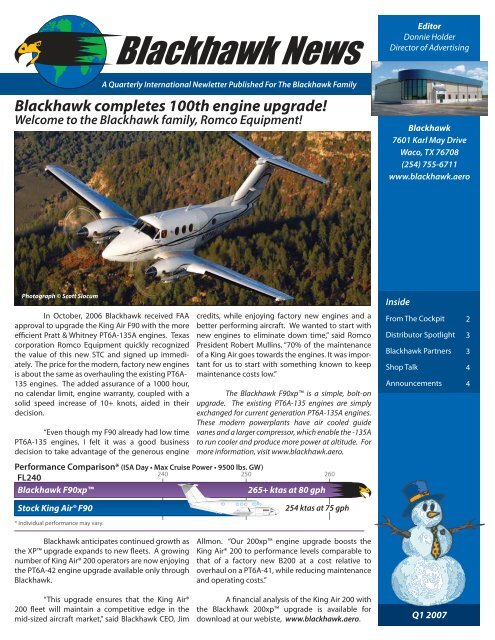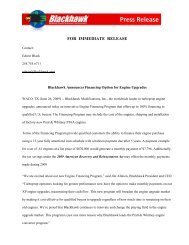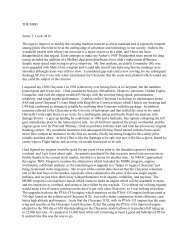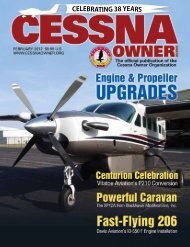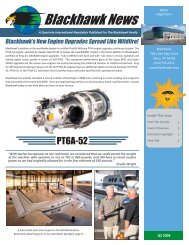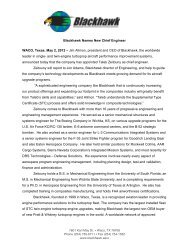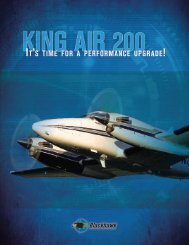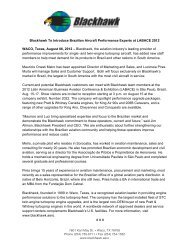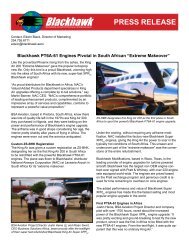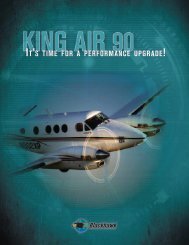Blackhawk News Q1 2007 (.PDF) - Blackhawk Modifications, Inc.
Blackhawk News Q1 2007 (.PDF) - Blackhawk Modifications, Inc.
Blackhawk News Q1 2007 (.PDF) - Blackhawk Modifications, Inc.
You also want an ePaper? Increase the reach of your titles
YUMPU automatically turns print PDFs into web optimized ePapers that Google loves.
Editor<br />
Donnie Holder<br />
Director of Advertising<br />
A Quarterly International Newletter Published For The <strong>Blackhawk</strong> Family<br />
<strong>Blackhawk</strong> completes 100th engine upgrade!<br />
Welcome to the <strong>Blackhawk</strong> family, Romco Equipment!<br />
<strong>Blackhawk</strong><br />
7601 Karl May Drive<br />
Waco, TX 76708<br />
(254) 755-6711<br />
www.blackhawk.aero<br />
Photograph © Scott Slocum<br />
Inside<br />
In October, 2006 <strong>Blackhawk</strong> received FAA<br />
approval to upgrade the King Air F90 with the more<br />
efficient Pratt & Whitney PT6A-135A engines. Texas<br />
corporation Romco Equipment quickly recognized<br />
the value of this new STC and signed up immediately.<br />
The price for the modern, factory new engines<br />
is about the same as overhauling the existing PT6A-<br />
135 engines. The added assurance of a 1000 hour,<br />
no calendar limit, engine warranty, coupled with a<br />
solid speed increase of 10+ knots, aided in their<br />
decision.<br />
“Even though my F90 already had low time<br />
PT6A-135 engines, I felt it was a good business<br />
decision to take advantage of the generous engine<br />
credits, while enjoying factory new engines and a<br />
better performing aircraft. We wanted to start with<br />
new engines to eliminate down time,” said Romco<br />
President Robert Mullins. “70% of the maintenance<br />
of a King Air goes towards the engines. It was important<br />
for us to start with something known to keep<br />
maintenance costs low.”<br />
The <strong>Blackhawk</strong> F90xp is a simple, bolt-on<br />
upgrade. The existing PT6A-135 engines are simply<br />
exchanged for current generation PT6A-135A engines.<br />
These modern powerplants have air cooled guide<br />
vanes and a larger compressor, which enable the -135A<br />
to run cooler and produce more power at altitude. For<br />
more information, visit www.blackhawk.aero.<br />
From The Cockpit<br />
Distributor Spotlight<br />
<strong>Blackhawk</strong> Partners<br />
Shop Talk<br />
Announcements<br />
2<br />
3<br />
3<br />
4<br />
4<br />
Performance Comparison* (ISA Day • Max Cruise Power • 9500 lbs. GW)<br />
FL240<br />
240<br />
250<br />
<strong>Blackhawk</strong> F90xp<br />
265+ ktas at 80 gph<br />
Stock King Air® F90<br />
* Individual performance may vary.<br />
260<br />
<strong>Blackhawk</strong> anticipates continued growth as<br />
the XP upgrade expands to new fleets. A growing<br />
number of King Air® 200 operators are now enjoying<br />
the PT6A-42 engine upgrade available only through<br />
<strong>Blackhawk</strong>.<br />
“This upgrade ensures that the King Air®<br />
200 fleet will maintain a competitive edge in the<br />
mid-sized aircraft market,” said <strong>Blackhawk</strong> CEO, Jim<br />
Allmon. “Our 200xp engine upgrade boosts the<br />
King Air® 200 to performance levels comparable to<br />
that of a factory new B200 at a cost relative to<br />
overhaul on a PT6A-41, while reducing maintenance<br />
and operating costs.”<br />
A financial analysis of the King Air 200 with<br />
the <strong>Blackhawk</strong> 200xp upgrade is available for<br />
download at our webiste, www.blackhawk.aero.<br />
<strong>Q1</strong> <strong>2007</strong>
General aviation is the<br />
primary training source<br />
of most commercial<br />
airline pilots.<br />
GAMA<br />
www.gama.aero<br />
<strong>Blackhawk</strong> <strong>News</strong><br />
From The Cockpit<br />
Jim Allmon, President<br />
jim@blackhawk.aero<br />
Not a day goes by that I don’t have someone<br />
ask me what effect the VLJ will have on the<br />
turboprop market. My answer is always, “Not much”.<br />
The VLJ is forecast to be the greatest thing since the<br />
Piper Cub and I do believe the VLJ will be a viable<br />
product in the years to come. The once hallowed<br />
ground of the “Jet Set” is now being replaced by the<br />
average “Joe Businessman” who sees private aircraft<br />
as a necessary tool rather than the luxury it was 20<br />
years ago. The VLJ could make private jet travel<br />
more affordable than anyone ever thought possible.<br />
I, however, take a different stance when someone<br />
regales me with the predicted doom of the impending<br />
turboprop market crash “just as soon as the first<br />
VLJ gets approved”.<br />
A year ago, one gentleman proclaimed that<br />
the average turboprop or cabin class twin would<br />
drop 50 percent in value as soon as the first VLJ<br />
rolled off the assembly line. This particular customer<br />
owned a late model Cessna 421C at the time. When<br />
I asked him what he thought his plane was worth<br />
then, he proudly claimed that his plane was easily<br />
worth $600,000 considering the times and equipment.<br />
I then asked him if he would take $300,000 for<br />
it and he suggested that I must have taken leave of<br />
my senses. I told him, “If the pre-owned cabin class<br />
market is going to tank, that means YOU have to be<br />
willing to accept that kind of price as well”. He<br />
recommended where I could stick my logic and<br />
hung up. It’s a shame; I was just getting warmed up!<br />
The first VLJ actually came off the line in<br />
1972 with the advent of the small and economical<br />
Citation 500. The Citation ISP became the first single<br />
pilot corporate jet approved and was considered at<br />
the time to be the death knells of the turboprop.<br />
Funny, I don’t remember seeing a flood of turboprops<br />
hit the market after that, much to Cessna’s<br />
chagrin. Remarkably Cessna, with all of its expertise,<br />
reputation and production capability only produced<br />
about 3800 Citation 500 series jets in 34 years (CE-<br />
500 through CE-560)! That averages only 112 per<br />
year. Between the various VLJ builders that are<br />
slated to bring their version of the micro-jet to<br />
market, they are projecting annual build quotas of<br />
900 – 1000 jets per year. This means they hope to<br />
“eclipse” Cessna’s 34 year sales record in less than<br />
four years! If you believe the manufacturers, they<br />
already have everything sold out for the next 4-6<br />
years. It does make you wonder, what are real sales<br />
and what is advertising hype? Maybe if I claim that<br />
we have sold over 100 <strong>Blackhawk</strong> upgrades in only<br />
six years, people will say “ME TOO!” and flock to buy a<br />
<strong>Blackhawk</strong>! But wait, we actually HAVE sold over 100<br />
<strong>Blackhawk</strong> upgrades in six years! Operators are<br />
standing by to take your call!<br />
Being a JET PILOT does sound pretty cool.<br />
When I earned my Citation type rating many years<br />
ago, I did feel a certain amount of swagger that I<br />
Jim Allmon, CEO and<br />
President of <strong>Blackhawk</strong><br />
<strong>Modifications</strong>, is an<br />
experienced pilot with<br />
8000 hours total time<br />
and more than 25 years<br />
experience in aviation<br />
sales and marketing.<br />
didn’t have before. I was an A-1 Sierra Hotel JET<br />
PILOT flying a hot little Citation ISP. Sure, I heard all<br />
the jokes about “bird strikes from the rear” and<br />
“flying a slow-tation”. They were just jealous that<br />
they weren’t a big time JET PILOT like I was. I<br />
thought the only thing that should have a prop on it<br />
was a boat.<br />
That was until the day that I was asked to fly<br />
my boss and four big ol’ Oklahoma oilmen and their<br />
baggage and golf clubs to Las Vegas from Tulsa.<br />
When I told my boss that we would either have to<br />
stop for fuel or leave a couple of his buddies, that<br />
was the end of my JET PILOT days. A month later, we<br />
were in a King Air® 200 and the Citation was just a<br />
short lived ego trip for me. My boss was practical<br />
and stopping for fuel or leaving a couple of his<br />
friends behind when they were going to Vegas was<br />
NOT an option.<br />
Several new VLJs have now been approved<br />
and a couple have even been delivered. So where is<br />
the sound of a crashing turboprop market? The King<br />
Air® market is hotter than ever. Owners are buying<br />
new <strong>Blackhawk</strong> XP upgrades in record numbers,<br />
flying them for 500 hours and selling them for more<br />
than they have invested in them in some cases.<br />
In the end it all boils down to utility. An<br />
airplane is a transportation tool. The cost of operation<br />
is defined in ‘seat miles’. How many can it carry<br />
for the distance that is your normal trip? Full fuel<br />
and two passengers might be just the ticket for<br />
some, but when the loads are serious you need a<br />
serious load hauler. The <strong>Blackhawk</strong> upgraded cabin<br />
class turboprop is still the most bang for the buck<br />
out there.<br />
Anyway, JETPROP PILOT sounds pretty cool too!
Distributor Spotlight<br />
Superior Aircraft Maintenance, <strong>Inc</strong>.<br />
2005 was a landmark year for Superior<br />
Aircraft Maintenance. Not only did they become a<br />
<strong>Blackhawk</strong> Authorized Distributor, but they also<br />
became a Raisbeck dealership, a Raytheon service<br />
center and dealers for Rockwell-Collins, Shadin,<br />
Meggitt/S-TEC and Garmin. In 2006, Superior broke<br />
ground on their new 24,800 square foot maintenance<br />
hangar at the Rogue Valley International -<br />
Medford Airport in Oregon, allowing Superior to<br />
work more aircraft simultaneously.<br />
“We continue to build our company so that<br />
we can add value for our clients and increase our<br />
<strong>Blackhawk</strong> Partners<br />
Edwin Black, Director of Marketing & Sales<br />
edwin@blackhawk.aero<br />
It is my pleasure to announce that <strong>Blackhawk</strong><br />
has entered into a partnership with Raisbeck<br />
Engineering, a first-rate and technically excellent<br />
company that provides performance improvement<br />
products for corporate and commercial aircraft. I<br />
was fortunate to spend my first eight years in<br />
aviation working with Raisbeck and feel it a privilege<br />
to continue my involvement now as a <strong>Blackhawk</strong><br />
team member. This new strategic alliance will synergize<br />
our efforts in improving the overall performance<br />
and productivity of the King Air.<br />
While <strong>Blackhawk</strong> enhances aircraft performance<br />
by increasing available horsepower with<br />
engine upgrades, Raisbeck improves performance<br />
through the infusion of advanced aerodynamic<br />
technology. With both companies working together<br />
in this integral partnership, we can combine our<br />
resources to provide the best performance and<br />
productivity available for your King Air, better even<br />
than factory-new models.<br />
James Raisbeck, Chairman, and his team of<br />
aviation experts have the remarkable ability to find<br />
aerodynamic opportunities hidden to others. Mr.<br />
Raisbeck enthusiastically began fine tuning the King<br />
Air in 1981 when he engineered its first enhanced<br />
performance system. Now, 2.6 decades later, his<br />
name is synonymous with the venerable aircraft.<br />
His success is rooted in one simple<br />
principle: “Our systems must provide operators<br />
much more than they pay for,” says Sam L. Jantzen,<br />
ability to provide<br />
outstanding service,” said<br />
Joe Keith, President of<br />
Superior Air. “As the<br />
aviation industry continues<br />
on its path of technological<br />
advancement in a<br />
time of change, it is our<br />
responsibility to keep<br />
pace.”<br />
Superior recently introduced a new King<br />
Air® upgrade package. The Futurefit is available for<br />
the King Air® 200/300 and consists of the Rockwell -<br />
Collins Pro Line 21 Integrated Display System,<br />
Raisbeck Performance Systems, the <strong>Blackhawk</strong> XP<br />
Engine Upgrade (King Air® 200 only) and other upgrades<br />
to make your aircraft better than new.<br />
Raisbeck’s General Manager and V.P. of Marketing.<br />
“In addition, our systems truly work! This is evident<br />
by the staggering number of aircraft owners and<br />
operators who continue to install Raisbeck systems<br />
on their factory-new and older model King Airs.”<br />
Thanks, in part, to innovators like Raisbeck<br />
and now <strong>Blackhawk</strong>, the King Air has become the<br />
single most successful serially produced aircraft of<br />
all time. In a 40 year span, the fleet now exceeds<br />
6,000! Beech has been complacent to modernize<br />
the King Air blueprint of previously certified models.<br />
Improvements are typically incorporated with the<br />
release of new models while older models remain<br />
frozen in time. As Beech continues to produce old<br />
generation King Airs, enterprising companies like<br />
Raisbeck and <strong>Blackhawk</strong> are utilizing the STC<br />
process to keep the fleet competitive.<br />
Many of the reasons a King Air appeals to an<br />
operator are the same reasons that have made<br />
Raisbeck and <strong>Blackhawk</strong> so successful. <strong>Blackhawk</strong>’s<br />
Pratt & Whitney PT6A XP engine upgrade alone<br />
improves the overall aircraft performance. Adding<br />
the Raisbeck EPIC performance system allows a King<br />
Air to safely access thousands of additional short<br />
and unimproved fields while increasing payload,<br />
range and speed. Also, combining the engine XP<br />
upgrade with the EPIC performance system markedly<br />
increases the King Airs resale value.<br />
This partnership will undoubtedly reshape<br />
the future of the King Air, while providing operators<br />
with the luxury of more capabilities and a renewed<br />
pride of ownership. After all, our customers are the<br />
reason we are in business and deserve the latest in<br />
technology. We are thrilled to synchronize our<br />
efforts with Raisbeck to perpetuate the next generation<br />
King Air, along with currently existing models.<br />
This allows us to continue providing you, our<br />
customers, with the absolute best performance for<br />
your aircraft.<br />
Superior recently sold and<br />
installed their first XP<br />
upgrade with many more<br />
to come.<br />
For more information, call<br />
Superior at (541) 842-2250<br />
or email John Demario at<br />
jd@samaintenance.com.<br />
<strong>Q1</strong> <strong>2007</strong>
Shop Talk<br />
Mike Moore, Technical Services Manager<br />
mike@blackhawk.aero<br />
Nearly two-thirds of all<br />
the hours flown by<br />
general aviation aircraft<br />
are for business use.<br />
GAMA<br />
www.gama.aero<br />
I don’t need to keep a cycle count. Do I?<br />
I have been looking at aircraft log books now for<br />
many years and it amazes me how many pilots and<br />
more pointedly, owner/pilots do not keep a cycle<br />
count record on their aircraft. There are surely many<br />
reasons for this oversight, mostly due to the fact that<br />
it’s not required by regulation. But none of these<br />
excuses could justify the added expense this omission<br />
could create.<br />
First of all let’s make sure everyone knows exactly<br />
what defines a cycle. Not to be confused with a<br />
landing count, a cycle is an engine start followed by<br />
the aircraft leaving the ground (a flight) and an<br />
engine shut down. This means that you could start<br />
your engines, take-off, land, take-off again, land,<br />
take-off again, land, then shut down your engines<br />
and count only one cycle and three landings. If,<br />
however, you start up, take-off, land, shut off the left<br />
engine to deplane passengers, start that engine,<br />
then take-off again, land, and shut down both<br />
engines, you now have split cycles. The right engine<br />
has accumulated one cycle for the trip while the left<br />
engine should have been charged two cycles.<br />
So what is the controlling factor that makes this an<br />
issue? In reality, what you are counting is the heating<br />
cycles of the critical rotating parts of the engine. As<br />
long as the engine is running, the operating<br />
temperature stays within an operating range,<br />
whether it is at full power or idle. At engine shut<br />
down the temperature falls below this range and the<br />
re-heating of the metal to the operating range is<br />
what imposes the molecular stress on the base<br />
metals of the rotating parts. Add to that the stresses<br />
imposed in opposition to the rotating plane of the<br />
parts caused by the turbulences of flight. Scientists<br />
and engineers that are far smarter than me have<br />
done studies and tests to figure out exactly what the<br />
safe heating and cooling cycle limits are for each of<br />
the rotating parts of your engine, and these limits<br />
Announcements<br />
are set in stone by<br />
the limitations and<br />
life limits set by<br />
Pratt & Whitney<br />
and are certified by<br />
the FAA.<br />
So how does this<br />
affect the value of<br />
your aircraft or the<br />
overhaul cost of<br />
your engine?<br />
According to Pratt & Whitney, there is no longer a<br />
formula for converting operating hours to cycles (as<br />
shown by example two above), even though some<br />
shops or overhaulers will count one cycle for one<br />
operating hour. Most likely, you are short changing<br />
yourself with this formula. If you send your engine<br />
to a Pratt & Whitney authorized overhaul facility for<br />
an overhaul and there are no cycle records, they will<br />
scrap all the time/cycles limited parts of your engine,<br />
which will add huge costs to the overhaul because<br />
they cannot confirm the actual cycle count on the<br />
parts. Now think about aircraft value. If you decide<br />
to sell your aircraft with no cycle record, how much<br />
will a prospective buyer pay knowing they will have<br />
to replace the rotating parts of the engine at<br />
overhaul? I’m sure it will be significantly less than the<br />
true value of your aircraft. After all, you just put<br />
factory new engines on it. So the long and short of it<br />
is, in order to ensure you keep the value increase<br />
those factory new engines added to your aircraft, it<br />
is imperative you keep an accurate cycle record.<br />
<strong>Blackhawk</strong> has even supplied you with a new cycle<br />
book. We recommend you keep it handy. It only<br />
takes an extra minute to properly fill it in before you<br />
leave the pilot’s seat. If you calculate the time spent<br />
vs. the cost savings, it could be the biggest hourly<br />
rate you’ve ever made.<br />
<strong>Blackhawk</strong> offers three new performance options.<br />
• Bleed Air Pressurization (King Air A90-B90)<br />
• Fuel Capacity Upgrade (King Air A90-C90B)<br />
• Digital Engine Instrument Package (King Air 90 series with XP upgrade)<br />
<strong>Blackhawk</strong> <strong>News</strong><br />
We are pleased to welcome our<br />
new Director of Marketing & Sales,<br />
Edwin Black. Welcome aboard!<br />
<strong>Blackhawk</strong> organizes Brazilian demonstration tour.<br />
<strong>Blackhawk</strong> <strong>Modifications</strong>, along with Raisbeck Engineering,<br />
Commuter Air Technology, Quick Aviação, Japi Aeronaves and Pratt<br />
& Whitney Canada will make serveral stops in Brazil to demonstrate<br />
the performance and value of the <strong>Blackhawk</strong> XP upgrade with the<br />
Raisbeck and Commuter Air Technology enhancements. The ‘Better<br />
Than New’ tour is currently scheduled for April 22, <strong>2007</strong> to May 3,<br />
<strong>2007</strong>.


